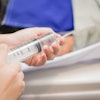Nonphysician practitioners' (NPPs) share of imaging interpretation in office-based medical practices has more than doubled over the past decade, from 2.52% of Medicare imaging studies in 2013 to 5.47% in 2022, according to a Harvey L. Neiman Health Policy Institute study.
The increase is by 117%, a team led by Eric Christensen, PhD, of the institute noted. The findings were published November 20 in the Journal of the American College of Radiology.
"We found that the NPP interpretation share more than doubled for x-ray, ultrasound, CT, and MR and nearly doubled for nuclear medicine," Christensen said in an institute statement. "This growth was fueled by a 141% increase in the number of NPPs providing care to Medicare patients over the decade."
The group based its research on more than 20 million office-based imaging studies for Medicare fee-for-service beneficiaries, tracking characteristics of the NPP providers and differences by state, the primary physician specialty of their employment practice, and imaging modality.
The team found the following:
| Increases in nonphysician practitioner interpretation share between 2013 and 2022 | |
|---|---|
| Modality | Percentage increase |
| MRI | 134.8% |
| Ultrasound | 124% |
| CT | 123.6% |
| X-ray | 114.5% |
| Nuclear medicine | 86.7% |
When the researchers compared the characteristics of the NPPs who interpreted imaging exams, they found the following:
- Male NPPs were 61% more likely than female ones to interpret imaging.
- Those younger than 55 were 41% to 43% more likely to interpret imaging than those 65 or older.
- Those in smaller practices were two- to three- times more likely to interpret imaging than those in large practices.
Nonphysician practitioner interpretation rates varied across states (for example, they interpreted more than 16% of x-rays in Alaska, Idaho, and Montana but less than 1% in Hawaii). The share of NPP interpretation also differed by employer practice specialty, with 74% of all primary care and orthopedic practice imaging read by them, the team reported.
The findings raise concerns about training gaps and the quality of NPP interpretations compared to radiologists, according to study co-author Richard Duszak, MD, of the University of Mississippi Medical Center in Jackson.
"Only about 2% of NPPs receive more than two days of exposure to radiology [in their training], compared to radiologist training that includes four years of medical school, a year of internship, four years of residency, a year of subspecialty radiology fellowship, and board certification," Duszak told AuntMinnie.com. "There's a huge opportunity here for standard setting by professional societies as well as regulatory bodies with regard to what degree of training, and validation of that training, is necessary for anyone to be effectively practicing as a radiologist."
The complete study can be found here.



















